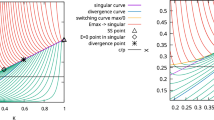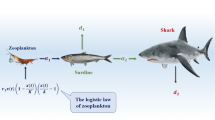Abstract
We present a mathematical model of two competing marine species that are harvested. We consider three models according to different levels of complexity, without and with species refuge and density-independent and density-dependent species movement between fishing area and refuge. We particularly study the effects of the fishing pressure on the outcome of the competition. We focus on conditions that allow an inferior competitor to invade as a result of fishing pressure. The model is discussed in relationship to the case of the thiof and the octopus along the Atlantic West African coast. At the origin, the thiof was abundant and the octopus scarce in that region. Since, the fishing pressure has strongly increased in some fishing areas leading to the depletion of the thiof and the invasion of its competitor, the octopus.





Similar content being viewed by others
References
Amaratunga T (1987) Population biology. In: Boyle PR (ed) Cephalopod life cycles, volume II: comparative reviews. Academic Press, London, pp 239–252
Auger P, Bravo de la Parra R, Poggicale JC, Sanchez E, Nguyen Huu T (2008a) Aggregation of variables and applications to population dynamics. In: Magal P, Ruan S (eds) Structured population models in biology and epidemiology, vol 1936: lecture notes in mathematics. Springer, Berlin, pp 209–263
Auger P, Bravo de la Parra R, Poggiale JC, Sanchez E, Sanz L (2008b) Aggregation methods in dynamical systems variables and applications in population and community dynamics. Phys Life Rev 5:79–105
Arístegui J, Barton ED, Álvarez-Salgado XA, Santos AMP, Figueiras FG, Kifani S, Hernández-León S, Mason E, Machú M, Demarcq H (2009) Sub-regional ecosystem variability in the Canary Current upwelling. Prog Oceanogr, 83(14): 33–48. ISSN: 0079-6611. doi: 10.1016/j.pocean.2009.07.031
Balguerías E, Quintero ME, Hernández-Gonzáez CL (2000) The origin of the Saharan Bank cephalopod fishery ICES. J Mar Sci 57(1):15–23. doi:10.1006/jmsc.1999.0572
Bravo de Laguna J (1982) Distribution and abundance of demersal resources of the CINECA region. Rapports et Procès-verbaux des Réunions du Conseil International pour l’Exploration de la Mer 180:432–446
Bravo de Laguna J, Balguerias E (1993) La pesqueria sahariana de cefalopodos: una breve revision. Bol Inst Esp Oceanogr 9(1):203–213
Brown SK, Auster PJ, Lauck L, Coyne M (1998) National Oceanic and Atmospheric Administration (NOAA). Ecological effects of fishing. NOAA’s State of the Coast Report. Silver Spring MD. http://oceanservice.noaa.gov/websites/retiredsites/sotc_pdf/IEF.PDF
Caddy JF (ed) (1983) Advances in assessment of world cephalopod resources. FAO Fisheries technical paper, 231:1–452
Caddy J, Rodhouse PG (1998) Comparison of recent trends in cephalopod and groundfish landings: an indicator of widespread ecological change in global fisheries. Rev Fish Biol Fish 8:431–444
Caverivière A (1990) Étude de la pêche du poulpe (Octopus vulgaris) dans les eaux côtières de la Gambie et du Sénégal. L’explosion démographique de l’éte 1986. Doc Scient Centre Rech Oceanogr Dakar Thiaroye 116:1–42
Caverivière A (1994) Le poulpe (Octopus vulgaris) au Sénégal : une nouvelle ressource. In: Barry-Gérard M, Diouf T, et Fonteneau A (eds) L’évaluation des ressources exploitables parla pêche artisanale sénégalaise. Paris, Orstom éditions, coll. Colloques et séminaires, Tome 2:245–256
Caverivière A (1997) Note sur l’observation de terriers creusés dans le sable et occupés par des juvéniles d’Octopus vulgaris. In: Rapport du groupe de travail ad hoc sur les cphalopodes. FAO, COPACE/PACE SERIES/97/63
Caverivière A, Diallo M, Domain F, Jouffre D (2000) Répartition côtière du poulpe Octopus vulgaris sur la Petite Côte du Sénégal et son exploitation par la pêche artisanale. In: Gascuel D, Chavance P, Bez, N, Biseau A (eds) Les Espaces de l’Halieutique. 4ème forum halieumétrique, Editions IRD, Paris, coll. Colloques et Séminaires, pp 269–283
Chavance P, Ba M, Gascuel D, Vakily M, Pauly D (2004) Pêcheries maritimes, écosystèmes et sociétés en Afrique de l’Ouest: un demi-siècle de changement [Marine fisheries, ecosystems, and societies in West Africa: 28 Juin 2002. Office des publications officielles des communautés Européennes, XXXVI, collection des rapports de recherche halieutique ACP-UE 15, Brussels
Demarcq H (2009) Trends in primary production, sea surface temperature and wind in upwelling systems (1998–2007). Progr Oceanogr, 83 (1–4):376–385. ISSN: 0079-6611
Diallo M, Jouffre D, Caverivière A, Thiam M (2012) The demographic explosion of Octopus vulgaris in Senegal during the 1999 summer. Bull Mar Sci 71(2):1063–1065
Diatta Y, Bou-Ain A, Clotilde-Ba F, Capapé C (2003) Diet of four serranid species from the Senegalese coast (eastern tropical Atlantic). Acta Adriat 44(2):175–182
Domain F, Jouffre D, Caverivière A (2000) Growth of Octopus vulgaris from tagging in Senegalese waters. J Mar Biol Ass UK 80(4):699–706
Heemstra PC, Randall JE (1993) FAO species catalogue, vol 16: groupers of the world (family Serranidae, subfamily Epinephelinae) an annotated and illustrated catalogue of the grouper, rockcod, hind, coral grouper and lyretail species known to date. Rome: FAO. FAO Fisheries Synopsis 125(16)
Jouffre D (1998) Octopus vulgaris as a component of the benthic fauna of the NW African coast: a note on an investigation of species community organisation using multifactorial analysis. S Afr J Mar Sci 20:93–100
Jouffre D, Inejih C, Simier M (2000) Cycle biologique du poulpe (Octopus vulgaris) au large du Cap-Blanc (Mauritanie). 4ème forum halieumétrique, “Les Espaces de l’Halieutique”. Paris, IRD, coll. Colloques et Séminaires, pp 243–267
Laurans M, Barry M, Gascuel D (2003) Revue des connaisances sur la biologie du thiof (Epinephelus aeneus) et diagnostic de l’etat du stock au Senegal. In: Gascuel D, Barry MD, Laurans M, Sidibe A (eds) Evaluation des stocks demersaux en Afrique du nord-ouest. Travaux du Groupe “Analyses monospecifiques” du projet SIAP. COPACE/PACE Series 03/65: pp 5–70
Meissa B, Gascuel D, Rivot E (2013) Assessing stocks in data-poor African fisheries: a case study on the white grouper Epinephelus aeneus of Mauritania. Afr J Mar Sci 35(2):253–267
Murray JD (2003) Mathematical biology I: an introduction. Springer, New York
Ndiaye W, Thiaw M, Diouf K, Ndiaye P, Thiaw OT, Panfili J (2013) Changes in population structure of the white grouper Epinephelus aeneus as a result of long-term overexploitation in Senegalese waters. Afr J Mar Sci 35(4):465–472
Nguyen-Ngoc D, Nguyen-Huu T, Auger P (2012) Effects of refuges and density dependent dispersal on interspecific competition dynamics. Int J Bifurc Chaos 22(2):1250029
Pereiro JA, et Bravo de Laguna J (1981) Dynamique des populations et évaluation des stocks de poulpes de l’Atlantique Centre-Est. FAO, COPACE/PACE SERIES 80/18
Rathjen WF, Voss GL (1987) The cephalopod fisheries: a review. In: Boyle PR (ed) Cephalopod life cycles, comparative reviews, vol 2. Academic Press, London, pp 253–275
Roy C (1991) Les upwellings: le cadre physique des pêcheries côtières ouest-africaines In: Cury P, Roy C (eds) Pêcheries Ouest-africaines, variablité, instablité et changement. O.R.S.T.O.M. Editions (Paris), pp 38–66
Thiao D, Chaboud C, Samba A, Laloe F, Cury P (2012) Economic dimension of the collapse of the false cod Epinephelus aeneus in a context of ineffective management of the small-scale fisheries in Senegal Afr. J Mar Sci 34:305311
Thiaw M, Gascuel M, Jouffre D, Thiaw OT (2009) A surplus production model including environmental effects: application to the Senegalese white shrimp stocks. Progr Ocenagr 83:351–360
Thiaw M, Gascuel M, Thiao D, Thiaw OT, Jouffre D (2011) Analyzing environmental and fishing effects on a short-lived species stock: the dynamics of octopus population, Octopus vulgaris, in the Senegalese waters. Afr J Mar Sci 33(2):209–222
Acknowledgments
This work was done while Doanh Nguyen-Ngoc was visiting at the Vietnam Institute for Advanced Study in Mathematics (VIASM). The author would like to thank to VIASM for financial support and hospitality. Didier Jouffre was assigned by IRD (Institut de Recherche pour le Développement) at the University Cheikh Anta Diop of Dakar (UCAD) to occupy a position of Deputy Director of the Laboratoire de Biologie et d’Ecologie de Poissons en Afrique de l’Ouest (LABEP-AO), a joint Laboratory between IRD (MARBEC Research Unit) and UCAD (Institut Fondamental d’Afrique Noire Cheikh Anta Diop). The author would like to thank to IRD for support and UCAD-IFAN for support and hospitality. This research is funded by Vietnam National Foundation for Science and Technology Development (NAFOSTED) under Grant Number 101.02-2013.18. This research is a Labep-AO contribution to the AWA project (www.awa-project.org) co-funded by the German (BMBF) and French (MAE) Ministries of Cooperation and Foreign Affairs.
Author information
Authors and Affiliations
Corresponding author
Appendix: Equilibria and Local Stability Analysis of Aggregated Model
Appendix: Equilibria and Local Stability Analysis of Aggregated Model
1.1 Rewrite Model
To simplify, we denote by \(f(n_1,n_2)\) the function \(A - Bn_1 - \dfrac{C}{H(n_1)}n_2\) and by \(g(n_1,n_2)\) the function \(M - Nn_1 - \dfrac{P}{H(n_1)}n_2\). The model is therefore written as follows:
1.2 Jacobian Matrix
1.3 Equilibria and Stability
-
At (0, 0):
$$\begin{aligned} J(0,0)& = \begin{pmatrix} A & 0\\ 0 & \dfrac{M}{\alpha _0 + m} \end{pmatrix} \end{aligned}$$The matrix has two eigenvalues A and \(M/(\alpha _0 +m)\). Therefore, (0, 0) stable if and only if \(M,A < 0\).
-
At \(\left( \dfrac{A}{B},0\right)\) (the condition for its existence is that \(A>0\))
$$\begin{aligned} J\left( \dfrac{A}{B},0\right) &= \begin{pmatrix} -A & -\dfrac{AC}{BH(\dfrac{A}{B})}\\ \\ 0 & \dfrac{M - N\dfrac{A}{B}}{\alpha _0 + m} \end{pmatrix} \end{aligned}$$The matrix has two eigenvalues: \(\lambda _1=-A <0\) and \(\lambda _2= (MB - NA)/(B(\alpha _0 + m))\). Thus, (A / B, 0) is stable if and only if \(MB - NA< 0\).
-
At \(\left( 0,MH(0)/P\right)\) (the condition for its existence is that \(M>0\))
$$\begin{aligned} J(0, MH(0)/P) &= \begin{pmatrix} \dfrac{PA-MC}{P} & 0\\ \\ \dfrac{MH(0)/P}{H(0)}g^{\prime}_{n_1} - \dfrac{MH(0)/Pg\alpha v_1^*}{H^2(0)} & -\dfrac{M}{H(0)} \end{pmatrix} \end{aligned}$$The matrix has two eigenvalues: \(\lambda _1=-M/H(0) <0\) and \(\lambda _2= (PA - MC)/P\). Thus, (0, MH(0) / P) is stable if and only if \(PA - MC< 0\).
-
At \((n_1^*,n_2^*)\) where \(n_1^* = (PA - MC)/(PB - NC)\), \(n_2^* = (A - Bn_1^*)H(n_1^*)/C\) (the condition for its existence is that \(0< (PA - MC)/(PB - NC) < A/B\)). The Jacobian matrix reads as follows:
$$\begin{aligned} J(n_1^*,n_2^*)& = \begin{pmatrix} n_1^*f^{\prime}_{n_1^*} & n_1^*f^{\prime}_{n_2^*}\\ \dfrac{n_2^*g^{\prime}_{n_1^*}}{H(n_1^*)} & \dfrac{n_2^*g^{\prime}_{n_2^*}}{H(n_1^*)} \end{pmatrix} \end{aligned}$$
A straightforward calculation leads to the following two possibilities (see Fig. 6 for more information). The first one, corresponding to conditions \(PA-MC>0\) and \(MB-NA>0\), is the case where \((n_1^*,n_2^*)\) is a stable point. The second one, corresponding to conditions \(PA-MC<0\) and \(MB-NA<0\), is the case where \((n_1^*,n_2^*)\) is a saddle point.
Rights and permissions
About this article
Cite this article
Nguyen-Phuong, T., Nguyen-Ngoc, D., Auger, P. et al. Can Fishing Pressure Invert the Outcome of Interspecific Competition? The Case of the Thiof and of the Octopus Along the Senegalese Coast. Acta Biotheor 64, 519–536 (2016). https://doi.org/10.1007/s10441-016-9292-1
Received:
Accepted:
Published:
Issue Date:
DOI: https://doi.org/10.1007/s10441-016-9292-1





